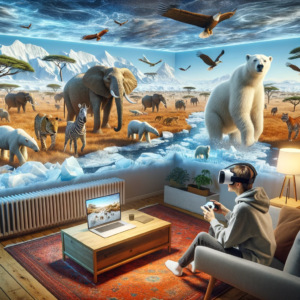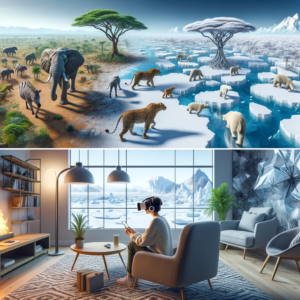“Immersive Ecotourism: Revolutionizing Conservation Through Virtual Reality” is a ground-breaking idea in the rapidly changing travel and technology industries. This topic gives your website, Virtual Reality Travel Experiences, an intriguing and distinctive slant by combining popular keywords like “virtual reality,” “immersive experiences,” and “ecotourism.”
Introduction
When combined with virtual reality (VR), immersive ecotourism offers a novel way to combine travel, technology, and environmental preservation. With the help of virtual reality, people can visit some of the planet’s most fragile and isolated ecosystems without ever having to leave the comforts of their homes. Virtual reality (VR) technology has advanced to the point where it faithfully recreates the sensory experience of being in a distant location, enabling users to explore, interact with, and learn about these surroundings in previously unthinkable ways.
Immersion ecotourism is expanding ideally with the wave of environmentally conscious travel. Growing numbers of tourists are looking for sustainable alternatives to travel the world as they become more aware of traditional tourism’s effects on the environment. Virtual reality (VR) is a unique opportunity to experience the excitement and knowledge of travel without the environmental impact of lengthy flights and ground transit.
Furthermore, immersive ecotourism via virtual reality is a teaching tool that raises awareness of the state of endangered ecosystems and the significance of conservation efforts rather than merely serving as a low-impact substitute for traditional vacation. It makes people more aware of the fragility and beauty of the natural environment, which promotes a more tremendous respect for biodiversity worldwide. Immersion ecotourism is unique because it combines an immersive experience with educational value, revolutionizing our understanding of travel, technology, and environmental responsibility.
Virtual reality and ecotourism: A New Frontier
Virtual reality (VR) has emerged as an invaluable instrument in environmental tourism, dramatically changing our comprehension of and interactions with the natural world. By pushing the limits of traditional sustainable tourism, this innovative media has changed how people approach education about the environment and preservation.
Critical advancements in virtual reality technology and software are driving this transformation. Contemporary virtual reality (VR) headphones offer unparalleled realism because of their accurate motion tracking, realistic audio systems, and displays with excellent resolution. Because of these technological improvements, it is now possible to produce impressively realistic depictions of real-world environments, such as the dense Peruvian jungle and the vast African grasslands.
These experiences are powered by equally outstanding software. Cutting-edge graphics engines vividly depict complex ecosystems, bringing every leaf, animal, and drop of water to life. These simulations’ AI-driven wildlife exhibits behaviors consistent with real-world biology, providing insight into the intricacy of natural environments. In addition to improving the user experience, this level of realism has educational value by offering insights into ecosystems that are frequently too fragile or unavailable to visit.
The virtual exploration of coral reefs is one prominent application of VR in ecotourism. Users can explore underwater environments where they can observe a plethora of life and gain knowledge about the delicate balance of marine ecosystems. These encounters frequently incorporate interactive components like species identification or online conservation games to increase their instructional value.
Similarly, virtual reality experiences that replicate trips to isolated jungles help people appreciate the significance of these environments. Through virtual interactions with the plants and animals, they can learn about these areas’ biodiversity and environmental difficulties. This entails becoming aware of the effects of deforestation and the significance of conservation initiatives.
Furthermore, real-time data from remote sensors positioned across these ecosystems is starting to be incorporated into VR experiences, offering live feeds and updates on the surrounding environment. This connection keeps consumers informed and involved while also improving realism and providing a dynamic, ever-evolving experience.
These virtual worlds are potent instruments for conservation as well as amusement. Virtual reality (VR) offers an intensely immersive experience that can strengthen human connections to the natural world. Link could increase people’s sense of urgency and responsibility for conservation activities, increasing their likelihood of supporting and participating in practical ecological initiatives.
In conclusion, a new frontier in environmental participation and education lies at the nexus of VR technology and ecotourism. Virtual reality (VR) has the opportunity to play a significant role in the future of conservation, raising awareness and spurring action to safeguard our planet’s ecological treasures by making endangered and endangered environments accessible to everybody.

Conservation and Awareness Through Virtual Reality
Using Virtual Reality to Promote Conservation and Awareness
Virtual reality (VR) technology in conservation has been increasingly effective, providing novel approaches to raise public awareness of environmental issues and safeguard threatened species and ecosystems. Virtual reality experiences that immerse users in lifelike simulations of natural ecosystems have the power to underscore the pressing need for conservation efforts and elicit a stronger emotional connection between users and the natural world.
The potential of virtual reality (VR) to make inaccessible or distant landscapes accessible to a worldwide audience is one of its most significant effects on conservation. For example, a virtual reality experience can take consumers to places like the deep ocean trenches, the dense Amazonian rainforest, or the melting Arctic ice caps—ecosystems that most people would never be able to visit in person. The suffering of these surroundings can become more accurate and captivating due to this virtual immersion, which can evoke a sense of presence and empathy.
Virtual reality (VR) has the potential to produce compelling stories about endangered species that highlight their lives, struggles, and natural habitats. Users can obtain a unique perspective on the challenges faced by endangered animals, such as habitat loss and poaching, by adopting the view of the animal in question. This compassionate approach can significantly alter public perceptions and motivate action.
Several projects and organizations have used virtual reality (VR) to help conservation efforts. For example, “Drop in the Ocean,” a VR experience created by Conservation International, transports users on an interactive tour across the ocean’s depths. This initiative aims to increase public awareness of the fragile condition of our oceans and the value of marine conservation.
The World Wildlife Fund’s (WWF) usage of virtual reality in their “Tiger Protector” campaign is another noteworthy example. Users can see the world through the eyes of tigers by donning VR headsets and traveling to Nepal’s jungles. This interactive experience aims to raise awareness and support for conservation initiatives related to tigers, specifically in the fight against poaching and habitat loss.
Virtual reality presents unmatched prospects in the field of environmental education. Educational institutions and ecological organizations increasingly use VR to teach the public and students about ecology, biodiversity, and the value of conservation. Younger audiences, frequently more open to technology-driven learning, can be especially well-engaged by these VR experiences.
Virtual reality (VR) can also benefit scientific study and wildlife management. For instance, researchers can study animal behavior in a controlled virtual setting using VR simulations, eliminating the need for invasive approaches in the wild. This strategy enhances scientific understanding while encouraging a more moral approach to wildlife study.

The use of VR in conservation needs to be revised, though. Making sure that these experiences are available to a large audience—including those who live in areas where environmental deterioration is most severe—is one of the main issues. Virtual reality technology can be prohibitively expensive and technically demanding, which may limit its application and influence.
Furthermore, although VR can be an effective tool for raising awareness and empathy, it cannot replace direct action and changing laws. For VR experiences to have a positive emotional impact, there needs to be a precise mechanism for people to support conservation initiatives through donations, advocacy, or lifestyle modifications.
Virtual reality has a promising and diverse role in supporting conservation initiatives. Virtual reality (VR) can change our perception of and interactions with the natural world by providing immersive experiences that promote empathy and understanding. The potential applications of virtual reality (VR) in conservation will only increase with the advancement and accessibility of technology, providing hope for a more ecologically conscious and sustainable future.
Economic and Environmental Impacts
Analyze the financial advantages of virtual ecotourism, particularly for those communities whose only source of income is traditional ecotourism. Talk about how virtual reality can provide a different income without having the same adverse environmental effects as travel. Examine the possibility of lower carbon emissions due to fewer travel days.
Aspects of Ethics and Education
Talk about the moral ramifications of online ecotourism. Think about how it allows access to sensitive or restricted regions without causing any disruption to the surrounding environment. Describe virtual reality (VR) teaching opportunities, including helping people comprehend the value of conservation efforts and biodiversity.
Obstacles and Prospects for the Future
Examine the difficulties that virtual reality has in reproducing real-world travel experiences. Talk about technology constraints, user accessibility, and the problem of producing emotionally compelling content. Contemplate how virtual reality technology may advance to improve the immersive ecotourism experience.
In summary
Summarize how virtual reality can revolutionize ecotourism in your conclusion. Highlight the advantages, including promoting sustainable travel practices, educational value, and support for conservation. Conclude by urging readers to research and back activities related to virtual ecotourism.
